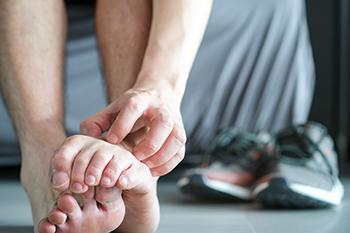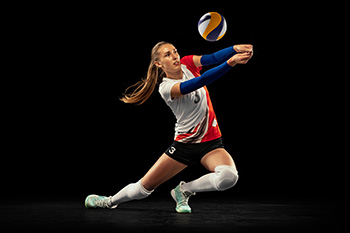Items filtered by date: November 2024
Tackling Athlete’s Foot

Athlete’s foot is a fungal infection that affects the skin on the feet, especially between the toes. It thrives in warm and moist environments, making locker rooms and damp socks ideal breeding grounds. Symptoms include itching, burning, peeling, and sometimes a red, scaly rash. In some cases, it may cause blisters or cracking skin. However, athlete's foot can resemble other skin issues like eczema or psoriasis, so proper diagnosis is essential. Antifungal creams and powders can be effective treatments for mild cases. For stubborn cases, prescription medication may be needed. To prevent athlete’s foot, keep feet dry and clean, avoid sharing footwear, and always wear flip-flops in communal showers and other damp areas. Opt for moisture-wicking socks and breathable shoes to reduce sweat buildup. If you have a stubborn case of athlete’s foot, it is suggested that you seek a proper diagnosis and treatment from a chiropodist.
Athlete’s foot can be uncomfortable and unsightly. To learn more about preventing and treating this condition, please consult with one of the chiropodists from Complete Family Footcare & Therapy. Our clinicians will assess your condition and provide you with quality foot and ankle treatment.
What Is Athlete’s Foot?
Athlete’s foot refers to an infection of the skin on the feet that is caused by a fungus. This fungus is contagious and thrives in warm and moist environments. It is often spread in common areas such as public pools, locker rooms, and showers. It can also spread when sharing personal items, like shoes or towels, with an infected person.
Symptoms
The symptoms of athlete’s foot may include:
Itching, stinging, or burning of the skin on the feet
Cracking or peeling skin, especially between the toes and on the soles of the feet
Scaly, red rash on the foot
Blisters
Foul odor
Treatment
Treatment for athlete’s foot typically involves using over-the-counter topical antifungal medications on the feet. When over-the-counter options are ineffective, you may need to take prescription oral medications or topical antifungal drugs, or a combination of both.
Prevention
Preventing athlete’s foot places an emphasis on good foot hygiene practices.
You can prevent athlete’s foot by:
Washing and drying your feet thoroughly every day
Wearing shoes when walking in public areas
Not sharing personal items, like shoes or socks, with others
Wearing shoes and socks made out of breathable materials
If you have any questions, please feel free to contact our offices located in . We offer the newest diagnostic and treatment technologies for all your foot care needs.
The Benefits of Coordination Exercises for Mobility

Coordination in the feet and ankles refers to the ability of muscles and joints to work together smoothly, allowing for controlled and stable movement. Good coordination means the feet can adapt quickly to uneven surfaces, maintain balance, and support the body effectively with each step. However, issues such as muscle weakness, joint stiffness, and nerve impairment can disrupt this coordination. When coordination is compromised, it becomes harder for the feet and ankles to respond to shifts in balance, leading to instability. This loss of coordination can increase the risk of falls and other injuries, especially in older adults. Conditions like arthritis, neuropathy, and weakened muscles further interfere with smooth movement, making it difficult to walk confidently. Strengthening exercises, balance training, and wearing supportive footwear, often guided by a chiropodist, can help restore coordination, improve stability, and protect overall mobility. If you have coordination issues related to your feet and ankles, it is suggested that you visit a chiropodist, who can assess foot mechanics, identify issues affecting balance, and provide tailored exercises to strengthen weak areas.
Stretching and strengthening your feet is very important for maintaining your foot health. If you would like to learn more about exercises for your feet, please consult with one of the chiropodists from Complete Family Footcare & Therapy. Our clinicians can help you maintain the health of your lower limbs and your mobility.
There are a variety of relatively easy-to-do exercises that can boost the strength, flexibility, and mobility of your feet, as well as relieve foot pain.
Strength exercises:
Toe splay - Spread the toes apart and hold for several seconds; improves control over toe muscles
Toe curls - Scrunch up a towel with your toes; strengthens the flexor muscles
Marble pickup - Pick up marbles with your toes; strengthens the muscles on the undersides of the feet and toes
Walking on sand - Stretches and strengthens feet and calves
Flexibility exercises:
Heel raises - Raise the heels while keeping toes on the ground
Toe point - Raise the heels while pointing the toes, keeping just the tips of toes on the ground
Toe curl - Raise the heels while curling the toes inwards, keeping just the tips of toes on the ground
Big toe stretch - Use your hands to gently stretch your big toes up, down, and to the side
Exercises for foot pain:
Toe extension - Gently pull the toes up towards the ankle and hold for several seconds
Ball roll - gently roll a golf or tennis ball underneath the arches of the feet
If you have any questions, please feel free to contact our offices located in . We offer the newest diagnostic and treatment technologies for all your foot care needs.
Toenail Care for Elderly People

As individuals age, proper toenail care becomes increasingly important for overall health and well-being. Neglecting toenails can lead to painful ingrown nails or infections, significantly affecting a person's quality of life. Maintaining healthy toenails involves regular trimming and cleaning to prevent the buildup of dirt and bacteria. Ensuring toenails are cut straight across helps avoid painful ingrowth. It is also important to monitor any changes in nail color or texture, as these may signal underlying health problems. For those individuals with diabetes or other chronic conditions, seeking professional care from a chiropodist can prevent complications. If you are a senior or are caring for an elderly person who has developed a toenail condition, it is suggested that you visit a chiropodist who can offer appropriate treatment solutions.
Foot problems can become increasingly common as we age, making everyday foot care especially important. To learn more about maintaining proper foot health, please consult with one of the chiropodists from Complete Family Footcare & Therapy. Our clinicians will assess your condition and provide you with quality foot and ankle treatment.
Common Foot Problems
Certain foot problems may be more likely to affect older adults.
Some examples of foot conditions that can be common in older adults include:
Dry, cracked skin
Calluses and corns
Blisters
Ingrown toenails
Deformities such as bunions or hammertoes
Fungal infections
Plantar warts
Systemic conditions, such as diabetes or arthritis, are also more likely to affect older people and manifest symptoms in the feet and ankles.
Daily Foot Care Tips
Having a daily foot care routine can help detect problems early on and prevent future issues.
Things that you can do at home to care for your feet include:
Washing the feet daily with warm water, drying them thoroughly, and then applying a moisturizer
Trimming the toenails straight across and not too short to prevent ingrown toenails
Performing daily foot exercises to improve foot strength and mobility
Wearing shoes when walking to avoid injury
Inspecting the feet daily for any cuts, scrapes, sores, or other abnormalities and seeking prompt treatment if any problems are discovered
If you have any questions, please feel free to contact our offices located in . We offer the newest diagnostic and treatment technologies for all your foot care needs.
Foot and Ankle Injuries Associated With Volleyball

Volleyball is a high-impact sport that can lead to foot and ankle injuries due to repetitive jumping, quick changes in direction, and sudden stops. Common injuries include ankle sprains, which occur when the ligaments are overstretched or torn due to landing awkwardly after a jump. Achilles tendonitis, caused by the overuse of the tendon during explosive movements, is also frequent in volleyball players. Stress fractures, which are tiny cracks in the bones, can develop from repetitive impact on the feet, especially during frequent jumping and landing. Plantar fasciitis, inflammation of the ligament that runs along the bottom of the foot, can result from the constant pressure placed on the feet. To minimize the risk of injury, volleyball players should wear supportive footwear and warm up properly. If you play volleyball and have incurred a foot or ankle injury, it is suggested that you visit a chiropodist for treatment.
Injuries to the foot and ankle are very common among athletes. If you have experienced an injury, please consult with one of the chiropodists from Complete Family Footcare & Therapy. Our clinicians will assess your condition and provide you with quality foot and ankle treatment.
Common Injuries Among Athletes:
Achilles tendon injuries
Ankle strains or sprains
Plantar fasciitis
Fractures
Turf toe
Joint dislocations
Sever’s disease
Morton’s neuroma
Symptoms
Symptoms will depend on the cause and severity of the injury. Common symptoms for a foot or ankle injury include pain, swelling, tenderness, bruising, a reduced range of motion, and difficulty bearing weight or walking on the affected foot or ankle.
Diagnosis
Sports injuries are typically diagnosed after carefully examining the affected foot or ankle. This includes moving the injured area to test its range of motion. Medical history will need to be provided, as well as detailed information about how the injury occurred. Imaging studies, such as X-rays or MRIs, may be used to confirm or rule out certain diagnoses.
Treatment
Just like symptoms, treatment will depend on the type of injury and its severity. Initial treatment for many sports injuries is aimed at controlling inflammation and promoting the healing response. The acronym R.I.C.E is a helpful guide to implement for most acute injuries. This method involves resting, icing, compressing, and elevating the affected foot or ankle. In addition, anti-inflammatory medications may be administered and orthotic devices may be prescribed. For more severe injuries, surgery may be required. Lastly, rehabilitation or physical therapy may be needed to gain full functionality in the afflicted area.
If you have any questions, please feel free to contact our offices located in . We offer the newest diagnostic and treatment technologies for all your foot care needs.

